FMS 1700MM F7F Tigercat
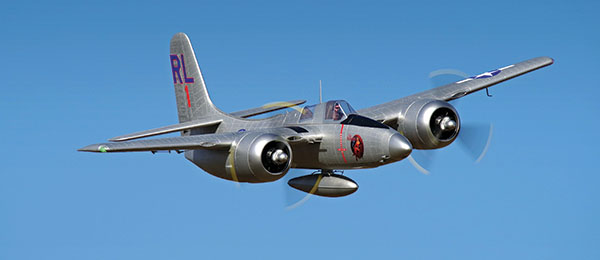
Written by Jon Barnes A highly detailed twin electric-powered aircraft. Product Review As seen in the March 2018 issue of Model Aviation.
Bonus Video
Specifications
Model type: PNP semiscale foam warbird Skill level: Intermediate Wingspan: 67 inches Wing area: 768 square inches Length: 58.5 inches Weight: 12 pounds Power system: Twin electric brushless Radio: Minimum six-channel required Construction: EPO foam Price: $549.99Test-Model Details
Motors: Predator 4250-Kv440 Speed controller: Predator 60-amp brushless with two EC5 connectors; external 10-amp BEC Battery: 6S 5,000 mAh LiPo Propeller: 14 x 8 three-blade Radio system: Spektrum DX9 2.4 GHz DSMX transmitter; Spektrum AR9020 receiver Ready-to-fly weight: 11.5 pounds Flight duration: 5 to 6 minutesPluses
• Highly detailed EPO-foam-composition airframe includes rivets and panel lines. • CNC-machined aluminum, suspension-equipped, retractable tricycle gear are scalelike in appearance and function. • Available in blue or silver color schemes; the blue model includes four graphics schemes. • 100% glueless assembly; the airframe goes together with 16 fasteners. • Use of integrated multi-pin connectors simplifies removal of wing halves for transport and storage.Minus
• Narrow battery compartment inhibits the use of wider form-factor 5,000 mAh batteries.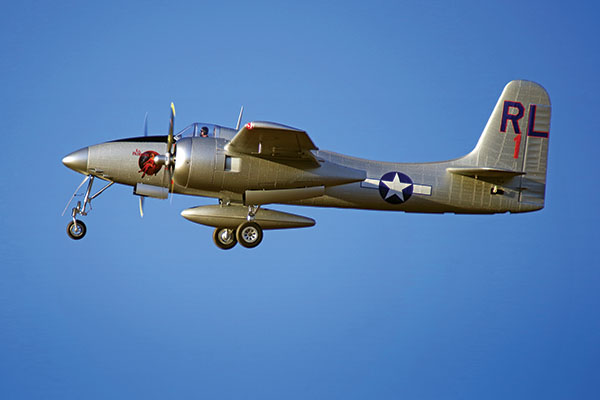
FMS did a fantastic job in modeling the trademark appearance and geometry of the Tigercat’s tricycle landing gear.
Product Review
Early in 1941, Grumman engineers set out to design the ultimate high-performance, carrier-based fighter aircraft. This airplane would be the third in a series of “Cat” monikered models that were produced by Grumman, with the company’s F4F Wildcat and F6F Hellcat both having served critical roles as Allied fighter aircraft during World War II. The third Cat in the Grumman litter, however, was destined be a twin. It would get its growl from a pair of battle-proven 2,100 hp Pratt and Whitney R-2800 Double Wasp 18-cylinder radial engines. The resulting Grumman design was eventually christened the F7F Tigercat. As designed, the full-scale aircraft proved to be too large and fast for carrier-based storage and operations. It was thus acquired and flown by the U.S. Marine Corps from land-based operations during the Korean conflict. Although aircraft undercarriages of the period still predominantly favored the tail-dragger configuration, the Tigercat employed a unique tricycle configuration undercarriage. The large-diameter main gear was designed to retract rearward into the engine nacelles, and the relatively long and spindly nose gear retracted rearward into the slender fuselage. World War II was over by the time flight testing was completed. The variety of resulting Tigercat variants that were produced would see it used as a fighter-bomber, a high-altitude photo-reconnaissance platform, and as a carrier-based, two-seat night fighter. FMS recreates all of the excitement of this historically significant Grumman-designed and manufactured twin fighter/bomber with the release of its large, 1,700mm wingspan, foam-composition F7F Tigercat. This Plug-N-Play (PNP) model is available in both a traditional dark blue color scheme, and a less-frequently modeled silver color scheme. The first option includes graphics that allow pilots to recreate one of four historically accurate Tigercat squadrons, while the latter one includes a factory-applied LaPatrona scheme. A full complement of metal-gear servos are used on the control surfaces. Of particular interest to scale warbird enthusiasts are the efforts by FMS to faithfully model the appearance and operation of the Tigercats’ unique tricycle-configuration landing gear. The scalelike detail of the suspension-equipped, CNC-machined aluminum landing gear is stunning! Other notable features include sequenced gear doors, LED navigation lights, and four-panel inboard/outboard flaps. The relatively large size of this foam-based model facilitates FMS achieving a new level of scale detail, with hundreds of individual rivets molded along every panel line. Pilots will need a minimum six-channel radio system and six-cell 5,000 mAh LiPo battery to complete this warbird.Construction
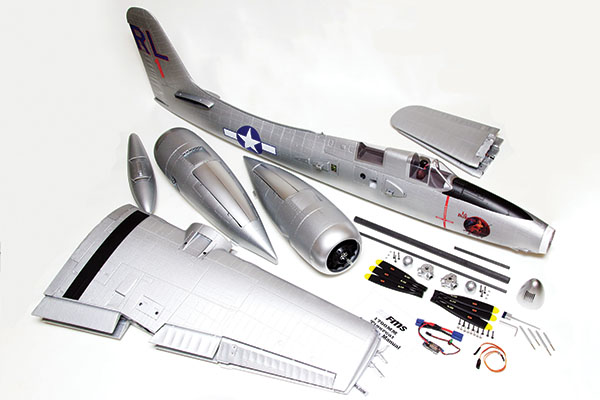
With all of the electronics and pushrods factory installed, assembling the Tigercat can be completed in a few hours by using a metric hex-head screwdriver and some contact-style cement adhesive.
As is now the case with many modern PNP kits, assembling the FMS F7F Tigercat primary airframe is accomplished without adhesives. Sixteen hex-head, machine threaded fasteners are all that stand in the way of this model being fully assembled. Four fasteners mount each large engine nacelle to its respective wing half, each wing half to the fuselage, and the pair of horizontal stabilizer/elevator assemblies to the fuselage. This approach facilitates the Tigercat’s easy disassembly for storage and transport. FMS uses an aggregating multi-pin connector for the wing wiring on each wing half, further simplifying the process. The Tigercat features independently driven inboard and outboard flaps, electric retracts, and factory-installed wingtip navigational lighting. The wiring, including the aileron servo wiring, is conveniently combined into a wing-root-mounted, self-aligning multi-pin connector. When mounting the engine nacelles to the wings, pilots should secure the throttle and landing gear servo extensions by using dental floss or appropriately tacky tape. FMS also includes a handful of scale outline-enhancing plastic details. Although the four gun barrels thread into the wing’s leading edges, pilots will need to muster a dab or two of adhesive to mount the plastic underwing pitot tube, canopy-mounted plastic antenna, and plastic nose cone. The included centerline-mounted external fuel tank can be added or removed at the pilot’s discretion, thanks to the use of a plastic rail-mounting system. Although both propellers on the full-scale Tigercat rotate in the clockwise direction as viewed from the pilot’s perspective, the FMS Tigercat comes out of the box with its twin power systems configured to counter-rotate. The probable design theory behind this decision is to help minimize the potential adverse yaw effects that are often inherent to twin electric-powered models. The threaded hub nuts used to secure the big three-blade propellers in place on the motor shafts both use conventionally pitched threads.
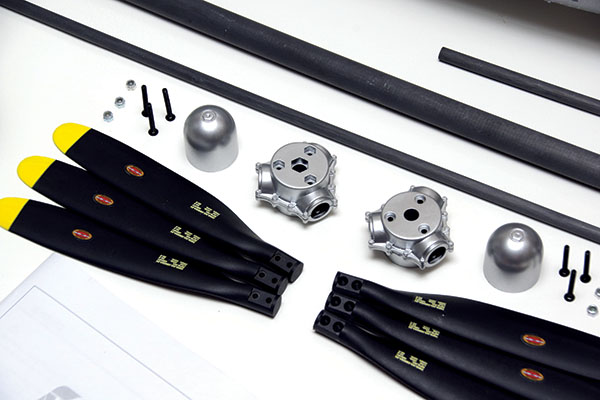
The preapplied military stencil and manufacturer’s logo graphics enhance the scale appearance of the three-blade propellers.
With one of the motors rotating in the reverse direction, the laws of physics dictate that the hub nut that is used on this motor could eventually work its way loose. Pilots should keep a close eye on both hub nuts and verify that they are still snugly torqued as a part of their preflight checklist. Warbird purists who place an absolute premium on scale fidelity might wish to cautiously experiment with reconfiguring the direction of the rotation to match the original airplane. Doing so is as easy as swapping any two leads on one of the motors.
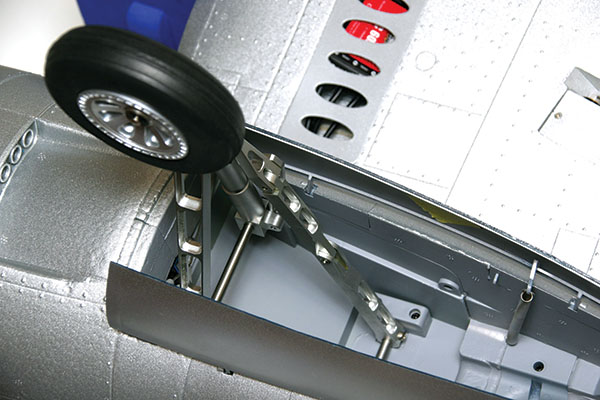
The suspension-equipped, machined-aluminum tricycle landing gear system, driven by electric retracts, are perhaps this model’s most impressive feature.
Flying
The full-scale F7F’s fuselage features a conspicuously narrow cross section. Pilots with broader shoulders often found the sveltely dimensioned single-seat cockpit slightly on the cramped side. FMS’ efforts to faithfully reproduce the Tigercat in all of its slenderly proportioned glory result in a battery compartment that might not accommodate six-cell 5,000 mAh LiPo batteries with wider form factors.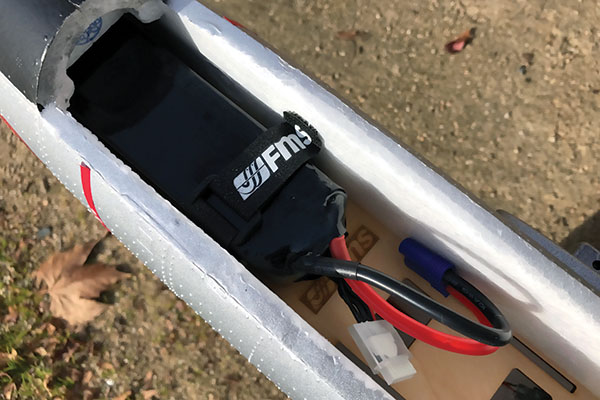
The relatively narrow dimensions of the battery bay preclude the use of wider form-factor six-cell 5,000 mAh packs.
Hitting the recommended center of gravity requires that the flight battery be positioned as far forward as possible. Battery packs with narrower proportions will work best in this model. The FMS decision to include an external 10-amp BEC will garner a nod of approval from most pilots, especially considering that the Tigercat comes with 10 digital servos installed. The suspension-equipped, CNC aluminum tricycle landing gear, designed by FMS for use in this model, stand out as some of the most detailed, aesthetically scale-looking and operating gear to ever appear in a foam model. Sequenced gear doors are included on both the main and nose gear. The full-scale Tigercat, when viewed from a side perspective, features a notably nose-high stance when it is sitting on the ramp. The geometry and configuration of the FMS Tigercat’s retractable gear fully captures the trademark stance of the F7F. The wide-set, 84mm-diameter mains and 62mm-diameter nose gear serve as an emphatic and enthusiastic yes to the often-asked question: Can this model be flown from grass runways? Pilots forced to operate from less-improved runway surfaces should find this model capable of handling the bumps and ruts that are inherent to grass fields. The tracking during departures is precise. Once trimmed out, this model will almost rotate into the air on its own. With the flaps set to the takeoff position, scalelike, shallow angle-of-attack departures are the order of the day. Larger models are known to fly better than their smaller counterparts. The increased weight and mass of larger models generally results in a model that penetrates better and tracks truer. With a 1700mm wingspan and a ready-to-fly weight of roughly 11 to 12 pounds, this model qualifies as one big kitty! Its inflight “purr-formance” is spirited and exhilarating! The motors chosen by FMS to anchor the twin, brushless, electric-power systems used in this model imbue it with the ability to perform aggressive warbird aerobatics and high-energy vertical transitions. Pilots might find themselves slightly surprised, but eminently satisfied, by this model’s pleasing power-to-weight ratio. Although each pilot’s unique throttle habits will ultimately determine how long the Tigercat can remain on duty before it needs to return to base, typical flight durations of between 5 and 6 minutes can be expected. When it is time to bring this big twin back in for a fresh battery pack, the large inboard and outboard flaps allow this model to perform comfortably controlled and authentically scalelike approaches and landings.
Conclusion
Warbird pilots are sure to be impressed with the large and luxuriously detailed FMS F7F Tigercat. This foam rendition of Grumman’s famous fighter/bomber achieves an extreme level of scale detail, with myriad individual rivets molded into the airframe along every panel line. The CNC-machined aluminum retractable tricycle landing gear is a veritable work of art, both aesthetically and functionally, and gives this Tigercat an authentic stance on the ramp and runway. A selection of spare parts is available directly from FMS via the company’s website.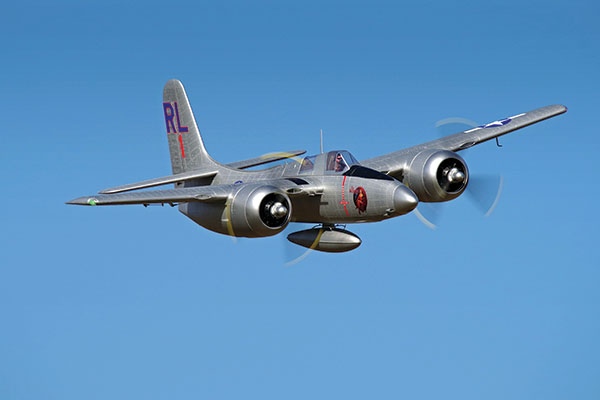
This big, high-performance, twin, electric-powered airplane is sure to satisfy warbird enthusiasts.
—Jon Barnes [email protected]










2 comments
This plane id on my want list
FMS F7F-3
Add new comment